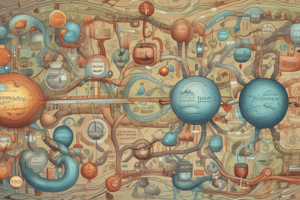Podcast
Questions and Answers
What is the primary function of catabolism in metabolism?
What is the primary function of catabolism in metabolism?
- To store energy for future use
- To build large molecules from smaller ones
- To break down large molecules and release energy (correct)
- To synthesize enzymes from amino acids
Which statement accurately describes an anabolic reaction?
Which statement accurately describes an anabolic reaction?
- It typically releases energy.
- It involves the degradation of protein.
- It occurs during the breakdown of glucose.
- It requires energy to proceed. (correct)
What is a key role of catabolic reactions?
What is a key role of catabolic reactions?
- Storage of energy
- Production of reducing power (correct)
- Regeneration of cellular nutrients
- Synthesis of molecules
What defines a metabolic pathway?
What defines a metabolic pathway?
Which metabolic process does glycolysis primarily involve?
Which metabolic process does glycolysis primarily involve?
How does the process of catabolism generally relate to energy?
How does the process of catabolism generally relate to energy?
Which of the following is a true statement regarding anabolic reactions?
Which of the following is a true statement regarding anabolic reactions?
What is the energy currency of the cell produced during catabolic reactions?
What is the energy currency of the cell produced during catabolic reactions?
What is the primary product formed when pyruvate is converted for entry into the TCA cycle?
What is the primary product formed when pyruvate is converted for entry into the TCA cycle?
Which stage of biochemical energy production occurs primarily in the mitochondria?
Which stage of biochemical energy production occurs primarily in the mitochondria?
What is the activated form of the acetyl group that enters the TCA cycle?
What is the activated form of the acetyl group that enters the TCA cycle?
What begins the process of biochemical energy production?
What begins the process of biochemical energy production?
Which of the following best describes the function of coenzyme A in acetyl group formation?
Which of the following best describes the function of coenzyme A in acetyl group formation?
What occurs after the small molecules resulting from digestion are absorbed into the bloodstream?
What occurs after the small molecules resulting from digestion are absorbed into the bloodstream?
Which of the following is NOT a product of the digestion stage?
Which of the following is NOT a product of the digestion stage?
Which metabolic pathway is often referred to as the Krebs cycle?
Which metabolic pathway is often referred to as the Krebs cycle?
What is the role of ATP in the initial stages of glycolysis?
What is the role of ATP in the initial stages of glycolysis?
How many total steps are involved in the glycolysis pathway?
How many total steps are involved in the glycolysis pathway?
Which reaction produces NADH during glycolysis?
Which reaction produces NADH during glycolysis?
What is the net gain of ATP from glycolysis?
What is the net gain of ATP from glycolysis?
Which enzyme catalyzes the conversion of fructose-1,6-biphosphate into two 3-carbon molecules?
Which enzyme catalyzes the conversion of fructose-1,6-biphosphate into two 3-carbon molecules?
In glycolysis, what happens to the glucose molecule after the first reaction?
In glycolysis, what happens to the glucose molecule after the first reaction?
Why does glycolysis occur twice per glucose molecule?
Why does glycolysis occur twice per glucose molecule?
Which of the following statements about ATP in glycolysis is accurate?
Which of the following statements about ATP in glycolysis is accurate?
Flashcards
Glycolysis Energy Investment
Glycolysis Energy Investment
The initial investment of ATP energy needed for the glucose molecule to begin glycolysis, a crucial step for the process to continue. This investment is required because the process needs energy to get started.
Glycolysis Pathway
Glycolysis Pathway
A sequence of 10 reactions breaking down glucose into pyruvate, yielding energy in the form of ATP and NADH.
Glycolysis Initial Steps
Glycolysis Initial Steps
The initial 5 reactions in glycolysis, requiring an energy investment (ATP) to proceed.
Substrate-Level Phosphorylation
Substrate-Level Phosphorylation
Signup and view all the flashcards
Net ATP Gain (Glycolysis)
Net ATP Gain (Glycolysis)
Signup and view all the flashcards
Glucose-6-phosphate
Glucose-6-phosphate
Signup and view all the flashcards
Pyruvate
Pyruvate
Signup and view all the flashcards
NADH Production
NADH Production
Signup and view all the flashcards
Gluconeogenesis
Gluconeogenesis
Signup and view all the flashcards
Glycogenolysis
Glycogenolysis
Signup and view all the flashcards
Glycogenesis
Glycogenesis
Signup and view all the flashcards
Citric Acid Cycle
Citric Acid Cycle
Signup and view all the flashcards
Acetyl CoA
Acetyl CoA
Signup and view all the flashcards
Coenzyme A
Coenzyme A
Signup and view all the flashcards
Digestion
Digestion
Signup and view all the flashcards
Metabolism
Metabolism
Signup and view all the flashcards
Catabolism
Catabolism
Signup and view all the flashcards
Anabolism
Anabolism
Signup and view all the flashcards
Metabolic Pathway
Metabolic Pathway
Signup and view all the flashcards
Glycolysis
Glycolysis
Signup and view all the flashcards
Study Notes
Metabolism
- Metabolism is the sum total of all biochemical reactions in a living organism.
- It's the central theme in biochemistry, keeping cells and organisms alive and providing energy for growth and propagation.
- Animal and human metabolism is conceptually divided into catabolic and anabolic reactions.
Types of Metabolism
1. Catabolism
- Catabolism involves breaking down large biochemical molecules into smaller ones.
- This process typically releases energy.
- The oxidation of glucose is a catabolic reaction.
- Key roles of catabolic reactions include: producing energy (ATP), reducing power (NADPH), and regenerating building blocks for anabolic reactions.
2. Anabolism
- Anabolism involves joining small biomolecules to form larger ones.
- Anabolic reactions typically require energy.
- The synthesis of proteins from amino acids is an example of an anabolic process.
- Catabolism and anabolism are opposite reactions; one releases energy, the other consumes it.
- Reactions are often organized into metabolic pathways.
Metabolic Pathways
- A metabolic pathway is a series of consecutive biochemical reactions that convert a starting material into an end product.
- Glycolysis, also called the Embden-Meyerhof Pathway, is a major pathway for carbohydrate catabolism, starting with glucose.
- It's an anaerobic process, meaning it doesn't require oxygen.
Glycolysis
-
Glycolysis can be divided into two main segments:
-
Investment of ATP: Without an initial ATP investment, glucose doesn't have enough energy for glycolysis to proceed, and ATP isn't produced. This involves the first 5 reactions of glycolysis.
-
Net energy yield: This includes the subsequent reactions in glycolysis, producing a net energy gain.
-
Glycolysis involves 10 steps, including reactions with specific enzymes.
- This includes reactions for Glucose, Glucose-6-phosphate, Fructose-6-phosphate, Fructose-1,6-biphosphate, DHA phosphate + Glyceraldehyde-3-phosphate, Glyceraldehyde-3-phosphate, 1,3-biphosphoglycerate, 3-phosphoglycerate, 2-phosphoglycerate, Phosphoenolpyruvate, and ATP Production.
-
Note: Reactions 6-10 occur twice per glucose molecule because the initial, six-carbon glucose is split into two 3-carbon molecules, generating 2 NADH and a total of four ATP molecules in the process.
-
The net ATP gain is only two, but there was an investment of two ATP molecules earlier in the process in the initial reactions, and that investment is paid back.
Conversion of Pyruvate to Acetyl CoA
- Under aerobic conditions, glucose can be completely oxidized to produce CO2.
- This happens in a pathway called the Citric Acid Cycle (TCA cycle) or Krebs cycle.
- Pyruvate, entering the mitochondria, is converted to a two-carbon acetyl group.
- This acetyl group is ‘activated' to join the TCA cycle when bonded to coenzyme A.
- CoA is derived from ATP and pantothenic acid; Acetyl CoA is the activated form of the acetyl group.
Overview of Biochemical Energy Production
- Energy production from food occurs in four major stages:
- Digestion: Breaking down food into smaller molecules (glucose, amino acids, fatty acids).
- Acetyl group formation: Small molecules from digestion are oxidized in the cytosol and mitochondria. This creates two-carbon acetyl units that attach to coenzyme A, along with reduced coenzyme NADH..
- Citric Acid Cycle: Acetyl CoA is oxidized in the mitochondria, producing ATP, NADH, and FADH2
- Electron Transport Chain and Oxidative Phosphorylation: NADH and FADH2 (from previous stages) supply fuel for producing ATP through a series of reactions that use oxygen.
General Metabolic Pathways
- Glucose, lipids and proteins undergo specific metabolic pathways that ultimately generate energy.
- The relevant stages in metabolism, for example, involve glycolysis (glucose metabolism), B-Oxidation (lipid breakdown), and oxidative deamination of proteins (releasing amino acids).
- These pathways often intersect and connect within the wider metabolic process.
Studying That Suits You
Use AI to generate personalized quizzes and flashcards to suit your learning preferences.




